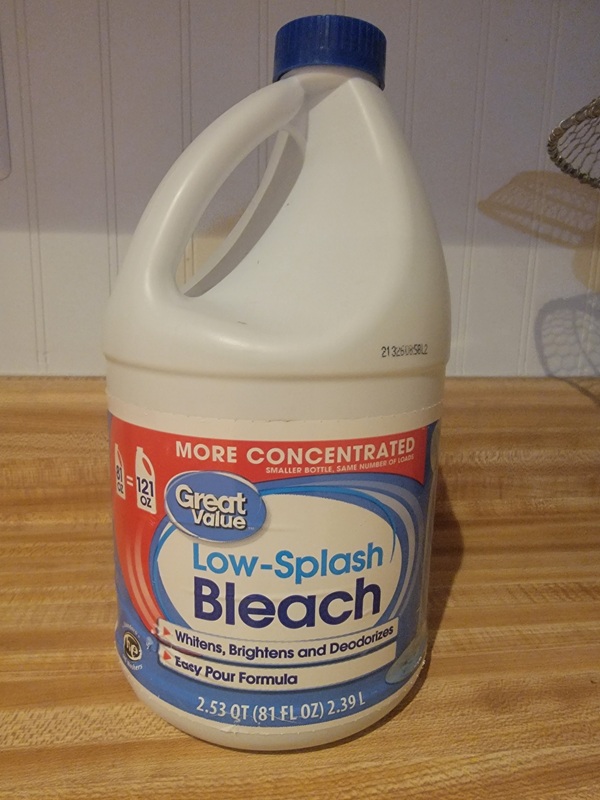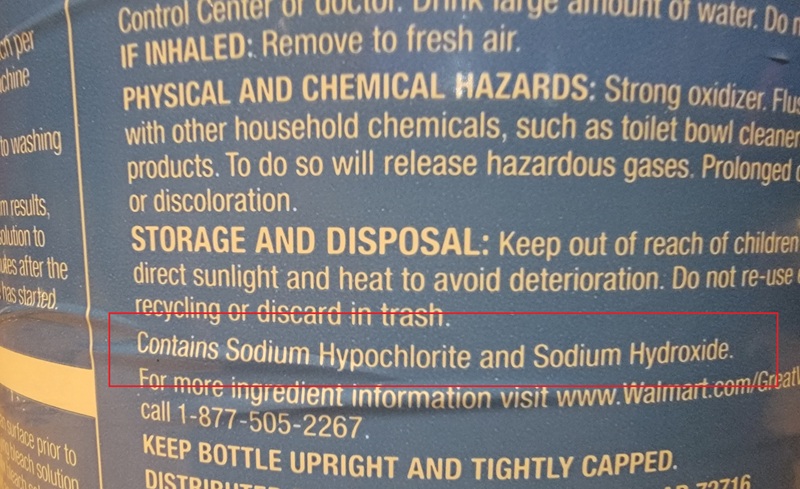I’ve been working at my preparedness for a good twenty years. I’ve learned a ton and know my fair share as a result. But there’s sometimes something that gets me from time to time. It’s usually a “little thing” but still problematic, nonetheless.
And that problem has spawned my most recent PSA: beware low-splash (or no-splash or splashless) bleach for water treatment!
You see, last week I’d decided to swap out water I store in the 55-gallon barrels in my garage. There are eight total, so about 400+ gallons of what I consider my initial emergency water storage. I do this every two or three years, and last week was that time again.
As usual, it took me a few hours to do, mostly because it takes a while to drain the barrels. But I speed things up by filling barrels as others drain. No big deal. As I neared the end of filling the barrels, I added some bleach, like I often do (but sometimes I don’t), then added more water to churn things up. Here’s what I bought at the store months ago:

It was “more concentrated” like almost all bleach solutions are these days. And, as always, I ensured it didn’t have any perfumes or dyes or anything like that. The ingredients are what I expected, too, sodium hypochlorite (the disinfecting part) and sodium hydroxide (the stabilizing part):

So, I didn’t think anything of it. But I must have never used “low-splash” (or “no-splash” or “splashless”) bleach before because it was clearly thicker that traditional bleach.
Since I was in a rush to be done, I begrudgingly used it, but something kept nagging me because it just didn’t feel right to me.
Earlier this week, I happened upon a comment on a YouTube video I was watching that confirmed what had been bothering me: you shouldn’t use low-splash bleach for water treatment because it contains unsafe chemicals!
I chose to verify this via my AI overlords:
If you’re wondering whether you can use low-splash or splash-less bleach for water treatment, the short answer is no—it’s not recommended.
Why Splash-less Bleach Isn’t Suitable for Water Treatment
- Lower Chlorine Concentration
Splash-less bleach is thicker and more viscous than regular household bleach, but most importantly, it often has a much lower sodium hypochlorite concentration—typically around 1–5%, compared to the usual 5–9% in standard bleach (watersystemscouncil.org, CDC, Wikipedia).- Additives May Be Unsafe
Manufacturers often include polymers or thickening agents in splash-less formulations. These additives make it unsuitable for treating drinking water, as they aren’t safe to ingest (Reddit, watersystemscouncil.org).- Water Treatment Requires Reliable Chlorine Content
Treating water—especially to make it safe to drink—requires precise, known dilutions of regular, unscented household bleach. For example, typical guidelines call for adding ~6–8 drops of regular bleach per gallon of water and allowing it to stand for 30 minutes (Reddit, Clorox™).
Saving You a Step: What to Use Instead
[FYI, I verified this elsewhere and I found similar concerns besides what ChatGPT states.]
Interestingly, the first reason ChatGPT gave was that it may have a lower chlorine concentration, but the bleach I purchased said “more concentrated” on the label, so I’m assuming that’s not a problem.
The bigger problem, and the reason for this PSA, are the polymers manufacturers include to thicken the bleach. From a health perspective this is THE BIGGER CONCERN! Worse, as with many labels, these additional ingredients aren’t listed and, I suspect, aren’t required to be listed because the manufacturers lobbied against it. But that’s just my guess. Regardless, I’m very unhappy.
Here’s The Underlying Problem
Maybe they (manufacturers and sellers) assume people won’t use bleach for water treatment and, thus, can get away with not fully labelling it or not explicitly stating “not for water treatment” or something like that. But when the CDC and nearly every other government authority recommend bleach as the second best option besides boiling, what do they think the average person is going to do? Are they really going to research whether “low-splash” bleach is safe before use? I doubt it.
[Side note: Another CDC article references using bleach for disinfecting purposes, but the only statement regarding low-splash or “splashless” bleach is with regards to lower chlorine concentration, not harmful polymers.]
Needless to say, I’m now in the process of completely draining, rinsing, and refilling my barrels this week. (I only griped and cursed about it for five or ten minutes, lol.) And, yes, redoing it all is a pain and certainly not something I wanted to do only days after having completed the job. But I learned a lesson and made a mistake … a mistake I absolutely won’t again!

Leave a Reply